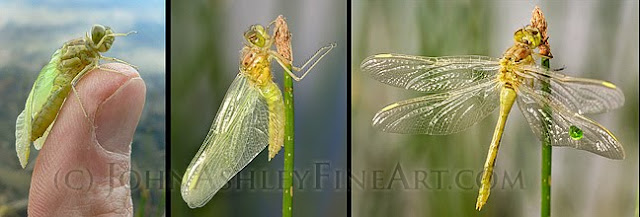Dragonfly eggs are most commonly laid underwater, where they hatch into nymphs and grow into formidible aquatic predators. After growing to optimal size -- 10 months to 3 years later -- the nymphs crawl out onto a rock or a plant stem, where they magically transform into something completely different.
Tracy found this emerging dragonfly (three frames above) recently while flipping our canoe over. I placed him back on a reed -- and then I ran for my camera gear so you could see his transformation.
In the first frame, he's probably about a 15-minute-old terrestrial insect. After crawling out of the water, he pushed and pulled his way out of his old skin ("exoskeleton") through a split along his back. His abdomon is now short and fat, full of valuable liquids that he'll need to inflate his wings. Free of the old skin, the wings start to slowly spread and enlarge. They are quite wrinkled and floppy at this stage, and he's still a ways away from making his first flight.
The second frame was taken just 10 minutes later. Now he's really pumping those abdominal juices into his new wings, and they're flattening out and taking shape. The new skin is starting to harden around his thorax, slowly turning from green to golden brown.
The third frame was taken 1 hour and 10 minutes after the first frame. The abdomon is now twice as long and half as wide. His wings are flat, full and just starting to firm up. Did you notice the green droplet in his right hind-wing? He's sprung a leak, and some of the abdomonal fluid is clearly visible. (Don't worry, the leak was self-healing and didn't hinder his progress.)
About two hours after crawling out of the water, our little dragonfly made his first flight. About a week later, his wings and skin will bear the yellow and gold colors that tell other dragonflies that he's now a mature, breeding adult. His transformation will then be complete -- from a formidible aquatic predator, into a voracious aerial predator.
Like bird biology, a lot of what we know about dragonflies has come from private citizens who "caught the bug," so to speak. (There's not much funding for bird and bug research.) Here in Montana, we know of about 60+ dragonfly species and 30+ damselfly species, including a handful of state-designated "Species of Special Concern" in both categories.
I think the dragonfly shown above is called a "Wondering Glider" (Pantala flavescens) but I'm no Odonata expert (pardon my Latin). You can also see a full-colored adult female Wondering Glider by clicking here (opens a new window).
Behind the lens: Photographed with two very different cameras. Left image created with "point and shoot" Panasonic DMC-FZ20 (a good choice if you might dump the canoe), hand-held on macro mode. Center and right images created with Nikon D700 on tripod with remote release, an antique 135mm f2.8 lens, and a 27.5mm Nikon extension tube.

